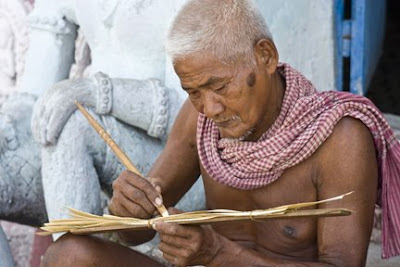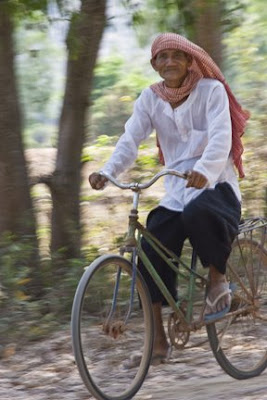 Check this out. There’s no shortage of fascinating things here to keep the western consumer amused. The seeds keep their suspension with the jelly-like juice. It’s very strange. (Google it, there are lots of photos.) It’s almost like a lava lamp except they aren’t moving. Oh and the taste? Not something to write home about (although I guess that’s what I’m doing eh). It’s syrupy sweet, and no I didn’t crunch down on the seeds. After the novelty, it isn’t something I’d purchase again. But it does have a great fan base, especially for fresh-made ones.
Check this out. There’s no shortage of fascinating things here to keep the western consumer amused. The seeds keep their suspension with the jelly-like juice. It’s very strange. (Google it, there are lots of photos.) It’s almost like a lava lamp except they aren’t moving. Oh and the taste? Not something to write home about (although I guess that’s what I’m doing eh). It’s syrupy sweet, and no I didn’t crunch down on the seeds. After the novelty, it isn’t something I’d purchase again. But it does have a great fan base, especially for fresh-made ones.
Spirit houses in Asia

 Spirits– can’t live with them, can’t live without appeasing them. In Asia, nature or ‘supernatural’ forces are very much a part of one’s being and not disconnected as it is in the modern west.
Spirits– can’t live with them, can’t live without appeasing them. In Asia, nature or ‘supernatural’ forces are very much a part of one’s being and not disconnected as it is in the modern west.
When people move into a new home they create a disturbance in the natural world. In a gesture of deference and to re-balance the natural surroundings, it is tradition to appease the displaced spirits. Bribes of various sorts ranging from incense, fruits, vegetables, water and rice etc are regularly placed in these houses, sort of like an eviction compensation. It isn’t that the spirits will actually eat them, and in fact some of these houses can be left in such a state as to seem that the spirits are expected to clean their little abodes. They will not. These are symbolic acts of respect towards the earth and to divine beings who live alongside us.
See the bananas and bottles of water in the first photo? On the road down to Koh Kong there are a few spirit houses placed along the sides of the road. Sometimes people will stop, leave a lagniappe and ask the spirits in that area to look over them in their travels and keep mischief and danger away. If many accidents have occurred on a specific road a spirit house will be placed there, to allow travelers to pacify the tormented spirits.
It’s interesting to note that I have never seen birds nesting in these houses, nor eating the plentiful fruits left at them. I hadn’t had a drop of clue or curiosity yet to ask my Khmer colleagues and friends why this is so. I guess it satisfies my sensibilities that it really does have to do with an otherwordly presence.
.
Irrawaddy dolphins in the Mekong

 Only four (five?) groups of freshwater dolphins are left in the world, mainly due to habitat loss and hunting– two in S. America and three in Asia. Here in Kratie, Cambodia, there are between 20 to less than 100 of the Irrawaddy dolphins. With such low numbers they are functionally extinct. They come to the Kratie area of the Mekong during the dry season (practically the only attraction there) and head up to Myanmar for the rest of the year.
Only four (five?) groups of freshwater dolphins are left in the world, mainly due to habitat loss and hunting– two in S. America and three in Asia. Here in Kratie, Cambodia, there are between 20 to less than 100 of the Irrawaddy dolphins. With such low numbers they are functionally extinct. They come to the Kratie area of the Mekong during the dry season (practically the only attraction there) and head up to Myanmar for the rest of the year.
.
Faces
Banana leaf books
 Since deciding to leave ‘civilisation’ I hardly much missed the comforts I was luckily blessed with. Lord knows my parents are confuzzled why I chose to go to a country worse off than the one they took me out of! I guess that choice is a luxury they passed on to us, but that’s where we see things differently… So instead there’s a daily onslaught of novel situations– sights, smells, tastes– not all good! But more often than not it’s a memory to put in that bottle.
Since deciding to leave ‘civilisation’ I hardly much missed the comforts I was luckily blessed with. Lord knows my parents are confuzzled why I chose to go to a country worse off than the one they took me out of! I guess that choice is a luxury they passed on to us, but that’s where we see things differently… So instead there’s a daily onslaught of novel situations– sights, smells, tastes– not all good! But more often than not it’s a memory to put in that bottle.
Here we saw an old man who lives at the temple on Phnom Chisour (2hrs’ motorbike ride from Phnom Penh). He writes Buddhist teachings on dried banana leaves cut into uniform ‘pages’, which are then tied together into a ‘book’. The implement is a branch with a sharpened end, and he fills in the strokes by rubbing a crushed leaf across the page. One book takes him a week to complete, and this he sells to tourists for $2. The skeptic in me wonders in which part of the pagoda do they mass-produce copies of these little books, and then age them over a fire or something. But as K and my photographer friend traipsed off to shoot all manner of inanimate curiosities, I stayed behind and watched him at length (like for 2hrs) painstakingly scrawl his messages. I even helped him pick leaves for ink (only the young leaves will do).
Yes, I bought one book from him. I have no idea what to do with it, so it sits with other dust-collecting ethnic baubles I purchase for the sake of stimulating the local economy.
View from shotgun
I don’t like riding in the back of the SUV like I have a chauffeur, but I also really hate traveling shotgun here for many reasons. The probability is high for anyone living here for being in an accident. Here are some photos why: Roads in developing countries aren’t the safest, so you can’t sit back and relax in the car. Almost every trip I make I pass an accident. On the national roads it’s even worse. Against your better sense of humanity, foreigners are advised never to stop and help, even if you’re with a local who can communicate. You can easily take the heat for the accident even if you arrive long after the event. And without an underlying structure of order, mob justice prevails. You’re on your own if any danger comes to you from being a good samaritan.
Roads in developing countries aren’t the safest, so you can’t sit back and relax in the car. Almost every trip I make I pass an accident. On the national roads it’s even worse. Against your better sense of humanity, foreigners are advised never to stop and help, even if you’re with a local who can communicate. You can easily take the heat for the accident even if you arrive long after the event. And without an underlying structure of order, mob justice prevails. You’re on your own if any danger comes to you from being a good samaritan.
 Motorbikes are used to transport anything and everything. These guys are each carrying two beds strapped precariously to their motos, traveling about 35km/hr for about 3 hours to Phnom Penh.
Motorbikes are used to transport anything and everything. These guys are each carrying two beds strapped precariously to their motos, traveling about 35km/hr for about 3 hours to Phnom Penh. Sights like these are common and, likelier than not, no matter how high a vehicle is packed, there are people sitting (or sleeping) on top of the cargo.
Sights like these are common and, likelier than not, no matter how high a vehicle is packed, there are people sitting (or sleeping) on top of the cargo.



